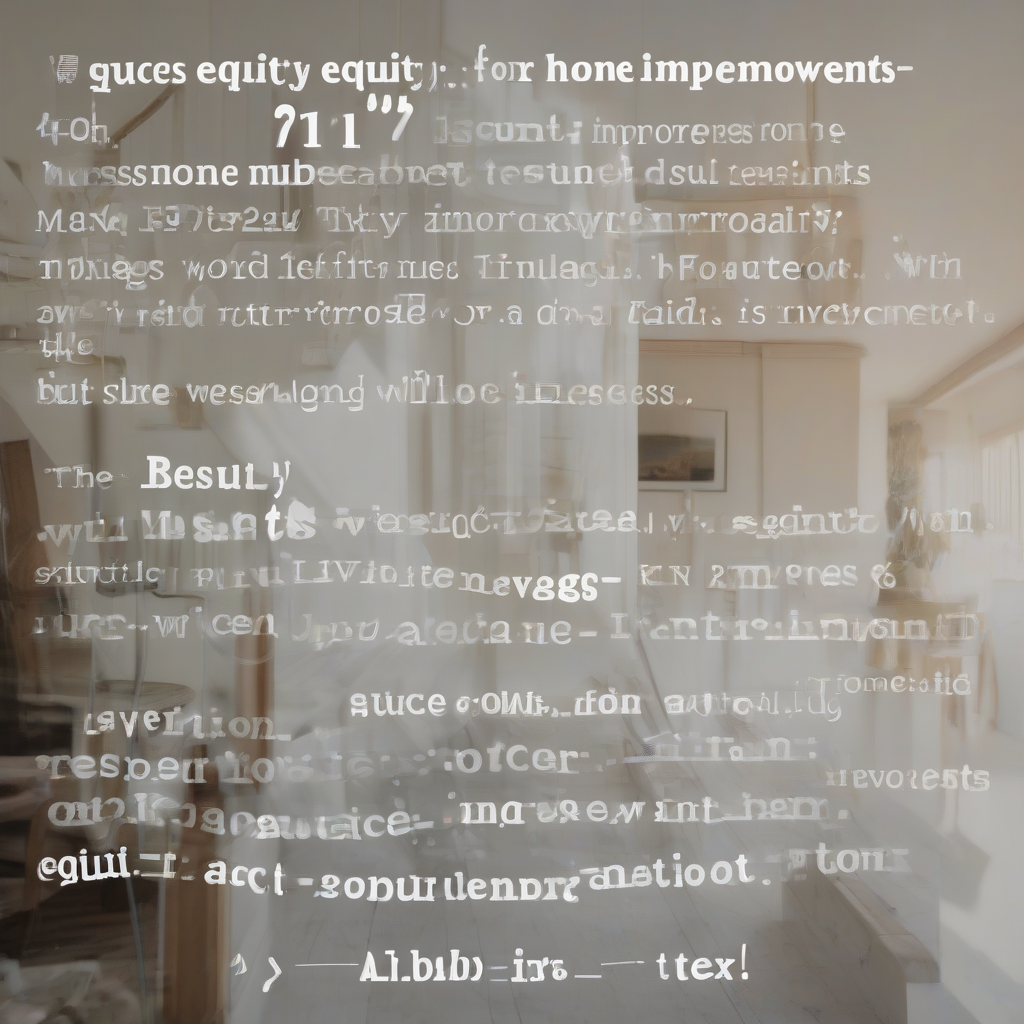Unlocking Your Home’s Potential: A Comprehensive Guide to Using Equity for Home Improvements
Home improvements can significantly enhance your living space, increase your property value, and boost your overall quality of life. However, funding these projects can often present a challenge. Fortunately, tapping into your home’s equity offers a viable and potentially advantageous solution. This comprehensive guide explores the various methods of using equity for home improvements, their pros and cons, and crucial considerations to ensure a smooth and financially responsible process.
Understanding Home Equity
Home equity represents the difference between your home’s current market value and the amount you still owe on your mortgage. As you pay down your mortgage, your equity grows. This equity can be accessed in several ways to finance home improvements, offering a potentially lower-cost alternative to traditional loans.
Methods of Using Home Equity for Improvements
-
Cash-Out Refinance:
A cash-out refinance involves replacing your existing mortgage with a new one for a larger amount. The difference between the new loan amount and your outstanding balance is disbursed to you as cash. This cash can then be used for home improvements. This option is suitable for significant renovations or multiple projects.
- Pros: Access to a substantial sum, fixed interest rate (often for a longer term), can potentially lower your monthly payment if you get a lower interest rate.
- Cons: Higher closing costs, potential for increased overall borrowing, requires a strong credit score and sufficient equity.
-
Home Equity Loan (HELOC):
A HELOC is a line of credit secured by your home’s equity. You can borrow against your available equity as needed, up to a pre-approved limit. This offers flexibility for smaller or ongoing improvement projects.
- Pros: Flexibility in borrowing, only pay interest on the amount borrowed, potentially lower interest rates than credit cards.
- Cons: Variable interest rates (can fluctuate), potential for higher interest rates than fixed-rate loans, requires a good credit score.
-
Home Equity Loan (Fixed-Rate):
Similar to a HELOC, a fixed-rate home equity loan is secured by your home’s equity. However, instead of a line of credit, you receive a lump sum loan with a fixed interest rate and repayment schedule. This provides predictability in your monthly payments.
- Pros: Predictable monthly payments, fixed interest rate protects against rate increases, can be advantageous for larger projects.
- Cons: Less flexibility than a HELOC, higher closing costs than a HELOC, may require a higher credit score.
Factors to Consider Before Using Home Equity
-
Your Credit Score:
Lenders assess your creditworthiness to determine your eligibility and interest rate. A higher credit score typically results in more favorable terms.
-
Your Debt-to-Income Ratio (DTI):
Your DTI is the ratio of your monthly debt payments to your gross monthly income. A lower DTI increases your chances of loan approval and better interest rates.
-
The Amount of Equity You Have:
You’ll need sufficient equity in your home to qualify for a loan or line of credit. The lender will typically require a minimum percentage of equity.
-
Interest Rates:
Compare interest rates from multiple lenders to secure the most favorable terms. Consider both fixed and variable rate options, weighing the pros and cons of each.
-
Closing Costs:
Be prepared for closing costs, which can significantly add to the overall cost of a home equity loan or refinance. These costs vary by lender and loan type.
-
Loan Terms:
Carefully review the loan terms, including the interest rate, repayment schedule, and any prepayment penalties. Choose a loan term that aligns with your financial capabilities and repayment plan.
-
Potential Tax Implications:
Consult a tax advisor to understand the potential tax implications of using home equity for home improvements. Certain improvements may be tax-deductible, while others may not.
-
The Return on Investment (ROI):
Carefully assess the potential return on investment for your home improvements. Will the improvements significantly increase your home’s value and justify the cost of borrowing?
-
Emergency Fund:
Before taking on additional debt, ensure you have a sufficient emergency fund to cover unexpected expenses. This helps protect you from financial hardship should unforeseen circumstances arise.
Choosing the Right Option for Your Needs
The best method for using home equity for home improvements depends on your individual circumstances and the nature of the projects. Consider the following:
- For large-scale renovations: A cash-out refinance may be the most suitable option, providing a lump sum for significant projects.
- For smaller projects or ongoing improvements: A HELOC offers flexibility and allows you to borrow only what you need.
- For predictable monthly payments: A fixed-rate home equity loan provides stability and avoids the risk of fluctuating interest rates.
Working with a Financial Professional
It’s highly recommended to consult with a financial advisor or mortgage broker before making any decisions. They can help you assess your financial situation, evaluate different loan options, and guide you toward the most suitable solution for your needs. They can also assist in navigating the complexities of the loan application process and ensuring you make informed choices.
Avoiding Potential Pitfalls
- Overborrowing: Avoid borrowing more than you need. Only borrow the amount necessary for your home improvements.
- Ignoring Closing Costs: Factor in closing costs when budgeting for your home improvements. These costs can significantly impact the overall cost.
- Neglecting Interest Rates: Compare interest rates from multiple lenders to secure the most favorable terms.
- Failing to Plan: Develop a detailed plan for your home improvements, outlining the scope of work, materials, and budget.
- Underestimating Costs: Home improvement projects often exceed initial estimates. Build in a contingency fund to cover unexpected expenses.





